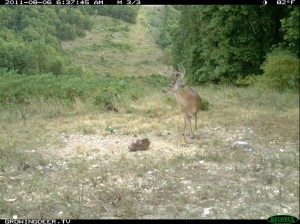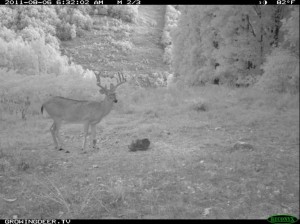Deciding My Harvest Objectives
Filed under: Deer Hunting, Hunting Blog
The old saying “You must know where you are going to get there” applies to deer hunting as much as other activities. By defining my harvest objectives, I have a much better chance of achieving my mission. I want to share in today’s blog my deer harvest objectives as deer season has begun or is about to begin throughout the whitetails’ range.
At my property, the harvest objectives are:
- To harvest as many does as necessary to balance the deer population with the habitat’s potential to provide quality forage during the periods of major stress (usually late summer and late winter).
- Allow bucks to mature to 4 years old or older.
I have objective #1 because I want quality forage available on a year round basis. Otherwise the deer couldn’t express their full fawn production or antler growth potential. Frequent watchers of GrowingDeer.tv know that I attempt to manage both the native habitat (using prescribed fire, timber management, etc.) and food plots to provide quality forage year round. Does are reproductive units – they produce fawns and the number of surviving fawns is the biggest factor in the deer herd’s current and future population.
If my quality food resources are becoming limited (known by checking browse pressure on preferred native species and using utilization cages in food plots) I must either create more quality food resources, reduce the number of deer competing for the food supplies, or do both simultaneously. Harvesting bucks is a very inefficient method to reduce deer populations. This is because one buck can breed many does. Hence, to limit fawn production, a vast majority of bucks must be removed annually. This results in a herd composed of mostly yearling bucks and gads of does. It rarely results in reducing the overall deer herd population – especially on a year to year basis.
To meet my habitat management objectives, my family, friends, and I will attempt to harvest approximately 2 does per 100 acres this fall. All the hunters at my place agree that harvesting does is one of the most enjoyable habitat management practices. I enjoy riding a tractor, but admit I’d rather be in a stand – I agree with my family and friends that harvesting does is an enjoyable habitat management activity. In fact, it is enjoyable twice! Once during the harvest activity and again when Mrs. Tracy prepares one of her wonderful venison dishes!!
I personally wish to harvest bucks that are four years old or older. Some of the primary reasons for this criterion are that antlers almost always increase in size with age (very few bucks – especially in my neighborhood) live past their prime body condition years. I’m not one bit afraid to admit I really enjoy seeing and harvesting bucks with large antlers. They thrill me as much as they did pre-historic men that painted antlers on cave walls throughout the world. I’m not sure what could be more natural than enjoying and harvesting bucks with large antlers! I also enjoy the challenge of attempting to tag a mature buck. Although the majority of venison my family consumes will be from does (doing habitat management and reducing my family’s grocery bill with extremely high quality meat!!) the buck I may harvest adds to our meat supply.
Another reason to allow bucks to mature is that they change the dynamics of deer herds. All the dynamics of mature bucks being present – pheromones, sign post, synchronizing breeding, reducing breeding activities of immature bucks, etc., are not totally understood. However the results (body weights, fawn production, antler development among all age classes, etc.) of a deer population that is in balance with the habitat’s ability to produce quality forage and has a mature age structure compared to herds that are malnourished and or have limited or no mature bucks is well documented.

 One of my harvest objectives for this fall is Clean 12. Clean 12 is a great buck for several reasons. He’s mature (probably 4 years old or older) based on the shape of his body. Hence, he’s survived at least four hunting seasons (as a 0.5, 1.5, 2.5, and 3.5 year old). There are 34 landowners that border my property. Many of these neighbors and their guests hunt and have different deer harvest objectives than me. Therefore Clean 12 is not easy prey. He has beautiful antlers – especially given there has never been a P&Y or B&C buck recorded in the counties (a county line splits my property) where I hunt.
One of my harvest objectives for this fall is Clean 12. Clean 12 is a great buck for several reasons. He’s mature (probably 4 years old or older) based on the shape of his body. Hence, he’s survived at least four hunting seasons (as a 0.5, 1.5, 2.5, and 3.5 year old). There are 34 landowners that border my property. Many of these neighbors and their guests hunt and have different deer harvest objectives than me. Therefore Clean 12 is not easy prey. He has beautiful antlers – especially given there has never been a P&Y or B&C buck recorded in the counties (a county line splits my property) where I hunt.
Those are the primary reasons Clean 12 is on my hit list. Take another look at the images of Clean 12. Did you notice the large wound on his left front leg? I’ve captured more than 50 images of Clean 12 this August during my annual camera survey. I never detected any sign of impaired mobility, leakage from the wound, etc., from those images. If I told you I was trying to harvest Clean 12 because he was suffering from injuries, I’d be lying – probably to myself more than to you.
I was (and still am) a hunter before I was a biologist. I’m thrilled that my hunting is a great tool to help improve deer herds! My family really enjoys the venison and time spent in a deer stand is very medicinal to the members of my family and me. Come September 15 (opening day for deer season in Missouri), I’ll be ready to begin my fall deer management activities.
Growing Deer together,
Grant



